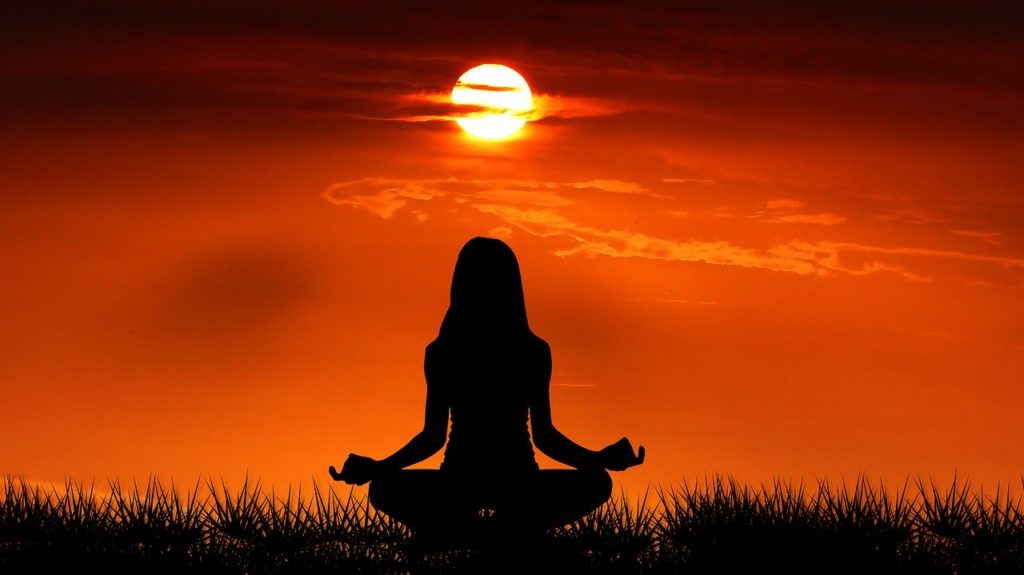
The word “Moksha” is derived from the Sanskrit word “Mukti,” which essentially means freedom. Moksha alludes to freedom from this material world and its painful bondages. This material world is characterized by four defects – birth, disease, old age, and death. All of these four conditions, coupled with the sufferings inflicted by natural disasters, other living beings, and the fear and anxiety of one’s mind, torment man throughout his life. According to Hinduism (Sanatan Dharma), Moksha is the condition where one is released from this cycle of birth and death and is happily united with God. Hence, Moksha is considered the ultimate goal of human life, and it is attained through discipline and spiritual practice. Moksha is a state of eternal bliss, devoid of any anxiety, where one realizes their spiritual identity and relationship with the Supreme Lord.
esa brahmi sthitih partha
nainam prapya vimuhyati
sthitvasyam anta-kale ‘pi
brahma nirvanam rcchati
(Bhagavad Gita 2.72)
–
This is the path of a spiritual and divine existence, upon achieving which one is not confused. By being situated in this way, even at the time of death, one can enter the realm of God.
There are five kinds of salvation (Moksha) that a spiritual practitioner can obtain at the end of his life in order to be released from the bondages of birth and death :
- Svarupya – Obtaining the same form as that of the Lord
- Salokya – One gets to reside in the same planet as that of the supreme Lord
- Sarsti – One attaining this liberation, acquires the same opulences as the Lord and lives in the Vaikuntha planets.
- Samipya – In this kind of liberation one becomes a personal associate of the Lord and stays in His direct association.
- Sayujya – Sayujya is the type of liberation wherein one loses his own identity and merges with the impersonal brahman effulgence of the Supreme Lord. In this kind of liberation, one does not get an opportunity to render any service unto the Lord upon liberation, as he is not able to realize the personal form of the Supreme. In other words, Sayujya Mukti is an unnatural state of existence, in which the soul ,though liberated from material bondage, is not able to establish his loving relationship with the Supreme Lord. Hence Sayujya Mukti is despised by the devotees, who even prefer going to hell instead. The Mayavadis, however, who do not believe that the Supreme Lord is a person, aspire for Sayujya Mukti.
Different Perceptions of Moksha in Hinduism – Advaita vs Dvaita
The advaita branch of Hinduism, who are essentially impersonalists, regard Sayujya mukti as the ultimate goal of human life. In the context of advaita schools, the soul and the Supreme Soul (God) are considered equal, and achieving liberation means realizing one’s own divinity. This leads to the dissolution of one’s false sense of individuality, and merging with the all-encompassing Supreme Being. It is often illustrated by the comparison of the soul to a drop of water that merges with the vast ocean, representing the Supreme Soul.

According to the dualistic traditions of Hinduism, as represented by the Dvaita Branch, God and the individual soul remain distinct from each other. Moksha, in this context, involves recognizing one’s spiritual nature as brahman and serving the Supreme Brahman (God) through surrender. An analogy often used is that of a green bird entering a green tree, representing the individual soul entering God, but still maintaining its own identity.
In the personalistic schools of thought, it is believed that the soul and God are forever separate, and any perception of merging is merely an illusion. In this case, the concept of oneness refers to a unity of purpose through loving service and the realization of one’s own godly nature as brahman, while still maintaining one’s individual spiritual identity. It is believed that entering God’s abode is the goal of liberation, though some schools of thought suggest that souls who have become free from material contamination are already liberated even before leaving the physical body.

Hence, the Dvaita branch of Hinduism regard Svarupya, Salokya, Sarsti, and Samipya, as the ultimate goal of human life. A devotee achieves one of the above states of liberation depending upon his mood and spiritual aspirations. As previously discussed, the followers of Dvaita schools consider Sayujya Mukti to be spiritual suicide where one merges with the Brahman effulgence of the Supreme Lord.
Attaining Moksha through Yoga
Achieving Moksha involves both spiritual practice and reliance on the grace of God. The Bhagavad Gita offers various paths that can be tailored to suit the spiritual inclinations and abilities of different practitioners. Below are brief summaries of the paths of Ashtanga Yoga, Karma Yoga, Jnana Yoga, and Bhakti Yoga. Yoga is not just about difficult physical postures or holding your breath, as many believe. The word “yoga” comes from “yuj,” which means “to yoke” or “to unite” in Sanskrit. The aim of yoga is to unite the body, mind, and spirit, as well as the individual self with universal consciousness. All forms of yoga practice are intended to lead one towards the realization of God. However, success in yoga depends on the quality of consciousness and the will of the Supreme Person, rather than physical prowess. The practice of yogic postures, breath control, and sense withdrawal is intended to calm the mind and focus one’s attention on the Supreme Lord, who is ever-present in our hearts.
buddhya visuddhaya yukto
dhrtyatmanam niyamya ca
sabdadin visayams tyaktva
ragadvesau vyudasya ca
vivikta sevi laghvasi
yatroparamate cittam
niruddhham yoga-sevaya
yatra chaivatmanatmanam
pasyan atmani tushyati
sukham atyantikam yat tad
buddhi grahyam atindriyam
vetti yatra na chaivayam
sthitas chalati tattvatah
yam labdhva caparam labham
manyate nadhikam tatah
yasmin sthito na duhkhena
gurunapi vichalyate
tam vidyad duhkha samyoga
viyogam yoga samjnitam
(Bhagavad Gita 6.20-23)
–
In the stage of perfection called samadhi (trance), one’s mind is completely restrained from material mental activities by the practice of yoga. This perfection is identified by one’s ability to see the self through the uncontaminated mind and to relish and revel within the Self. In that blissful state, one is situated in boundless transcendental happiness, realized through spiritual senses. Situated thus, one never strays from the truth, and upon gaining this he thinks there is no greater gain. Being established in such an exalted position, one is never shaken, even amidst the greatest obstacle. This indeed is actual freedom from all miseries stemming from material contact.
#1 Ashtanga Yoga – Ashtanga Yoga is based on the Patanjali Sutras, consisting of 194 aphorisms, divided into four sections: samadhi, sadhana, vibhuti, and kaivalya. Ashtanga yoga comprises eight stages, of which Hatha Yoga is related to the physical postures stage. The purpose of yoga is self-realization, achieved through the control of the mind and senses. The popular Hatha Yoga of today is just one of the eight stages, which prepares the body to stay in postures for long periods. The final stage, samadhi, involves pushing the soul out of the body and is known as Kundalini rising. However, this type of yoga is difficult to practice in modern times. The Vedic literature does not recommend ashtanga-yoga for spiritual perfection in the current age of Kali-yuga.

#2 Karma Yoga (the yoga of selfless action) – Realizing that selfish actions bind the soul, Karma Yoga involves giving up the results of actions to avoid reactions to self-centered activities. This path does not require giving up the activity itself but rather linking all activities to a higher cause. Karma Yoga involves offering various sacrifices to various deities to attain material blessings in this life and the next, without accruing any reaction. At its highest level, Karma Yoga means dedicating all activities to serving the Supreme Lord. Karma Yogis tend to have a progressive attitude towards the material world, and their aim is often to reach the heavenly planets.
#3 Jnana Yoga (the yoga of philosophical inquiry and wisdom) – Jnana Yoga involves evaluating ideas through logic and discourse to ultimately comprehend the self. It is the realization of the self through philosophical discussions and discrimination between matter and spirit through mental speculation. Jnana Yoga promotes knowledge through seclusion, study, and sense abnegation, minimizing the activities and necessities of life to become free from sensual desires that deceive the soul. Jnana Yogis aim to attain liberation by rejecting matter.
#4 Bhakti Yoga (the path of devotional service) – Bhakti Yoga involves reawakening the transcendental loving relationship between God and the living entity, through pure devotion that is free from all traces of Karma and Jnana. Devotees established in Bhakti Yoga serve the Lord constantly, engaging their minds, intellects, and senses in the Lord’s service. Bhakti Yoga purifies and frees one from all material designations, and upon attaining pure love of God, one is freed from all attachments and detachments and takes no pleasure in material things.
yoginam api sarvesam
mad-gatenantar-atmana
sraddhavan bhajate yo mam
sa me yuktatamo matah
(Bhagavad Gita 6.47)
–
And of all yogis, he who always abides in Me (Krishna) with great faith, worshiping Me in transcendental loving service (bhakti), is most intimately united with Me in yoga and is the highest of all. That is My opinion.
Bhakti Yoga is often considered the path most recommended in the Bhagavad Gita, as it combines all other types of yoga when perfected. It includes external and symbolic worship of the deity, practices such as pilgrimage, and the sophisticated processes of inner development like mantra meditation. Bhakti is not limited to those with emotional rather than intellectual dispositions, as emphasized by theologies of Ramanuja, Madhva, and Vallabha. They stress the importance of developing bhakti based on spiritual knowledge, often received through the guru, the mediator of God’s mercy. Bhakti Yoga is sometimes considered the synthesis and ultimate goal of Karma and Jnana, aiming for pure, selfless service to the Supreme Lord beyond fruitive results and liberation.